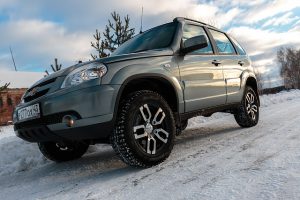Regularly cleaning your wheels and tires is important to keeping them looking great. It is also a very important practice for the preventative maintenance of your vehicle. Allowing break dust to build up on your wheels can be highly corrosive to your vehicle. Additionally, the long-term effects of UV rays…
5 Winter Driving Tips to Protect Your Wheels & Tires
Driving during the Winter can be both difficult and stressful. Therefore, it is best to know and apply every possible advantage to your vehicle to combat the cold weather, ice, and snow when driving in Winter conditions.
Snow Tires for More Traction
Winter Tires are particularly helpful when it comes to turning and stopping. This increased grip will help avoid skidding and accidents on the winter roads.
After buying a snow tire, drivers may realize that their hubcaps and center caps do not fit their new winter tire. In addition, the hazardous roads can lead to hubcaps falling off your wheels and getting lost on the Winter roadways. Driving without a hubcap can lead to your brakes freezing up after being packed full of ice.
Blackburn OEM Wheel Solutions offers a large selection of hubcaps, center caps and wheels to accommodate your vehicle in the winter months. Browse with Blackburn’s Wheelfinder to find the wheel, hubcap or center cap made to fit your snow tire.

Solutions When Stuck
If your wheels are stuck in the snow there are several solutions to get you out and back on the roadways.
Applying Kitty Litter behind your wheels can help give your tires more traction when attempting to drive out of the snow. Kitty Litter will not only provide additional traction for your tires but can also melt snow and ice in the process.
Other household items can also be placed under your wheel to create additional tire traction. Floor mats or anything with a stiff plastic edge such as expired credit cards, used gift cards or obsolete CDs can help get your vehicle free of the snow. Utilizing any of these items is a better exit solution than spinning your wheels in the snow. Be sure to not use anything important, because it will likely be damaged or destroyed in the process.
Your wheel may become damaged while attempting to get out of a snow ditch. Blackburn OEM Wheel Solutions offers Alloy Wheel Refinishing service to recondition wheels.
Check Tire Pressure Frequently
The air pressure in your tires will fluctuate a lot during the Winter months. Driving with underinflated tires can lead to higher fuel economy costs, faster tire wear, and even tire failure. Oppositely,
driving with overinflated tires can also lead to excessive tread wear and even cause a tire blowout.
As a result, you will want to keep a pressure gauge in your car to check your tires consistently as the temperature changes. You can check the sticker on the inside of your car door, car manual, or even the wheel itself to determine the correct amount of air pressure needed for your specific tire.
Local gas stations typically have air pumps to inflate your tires to the correct pressure. You can also purchase a portable air pump to both add and remove air from your tires in your own driveway.

Check Tread Depth
It is also important to frequently check the tread depth of your tires in the Winter. A deeper tread will give your tires more traction since there is more space for the snow to go. A lack of tread can lead to hydroplaning on wet roadways or skidding on slush, ice, or snow covered roads.
The easiest way to measure your tire tread will cost you just twenty-five cents. Take a quarter and place it in your tire tread facing downward. If the tread touches Washington’s head then you have a deep 4/32 inch tread. If your tread falls below 4/32 inch then you will need to replace your tires soon. Having a 5/32 inch tire tread is recommend for Winter driving.
You can also use the same method with a penny to measure minimum tire tread. If you can see all of Lincoln’s head then your tire tread is below 2/32 inches. You will need to replace your tires immediately regardless of what time of year it is.
Know the Capabilities and Limitations of Your Vehicle
It is well-known that 4-wheel and all-wheel drive vehicles are the best to drive when the weather gets bad, but that does not make them completely unsusceptible to crashes. Four-wheel and all-wheel drive vehicles accelerate better on icy or snowy roads than two-wheel drive vehicles. However, turning and braking can still cause sliding, skidding, and crashes.
Most modern vehicles now have electronic traction and stability control which helps the driver maintain control of their vehicle through the brakes. Stability control is best used to keep your car from spinning out on icy roads. Traction control helps prevent wheel spin when driving but should be turned off if you get stuck in the snow.
It is important to know that every vehicle has its limitations, including those built specifically for Winter weather conditions. The best advice is to take your time when the conditions get bad and not treat the roadways like a racetrack.







